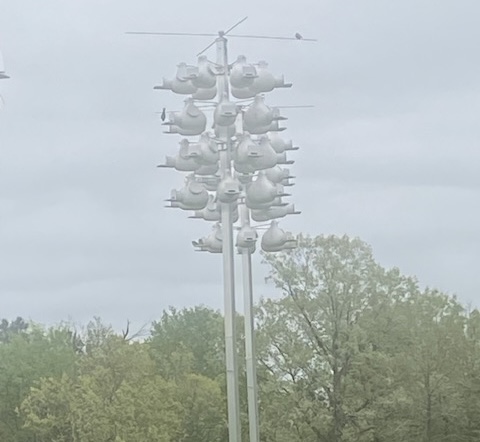The first day of Spring, March 20, is a special day for folks around these parts who are dog tired of winter. Although we don’t have winters like our friends up north, we still have tocontend with drab landscapes, an occasional frost, cold rains and incessant wind. However, the calendar says it’s spring so we have reason to celebrate.
Already our hardwood trees have fresh green leaves and lawns are escaping the dull gray of winter and now are begging to be mowed. My huckleberry bushes are sporting little green berries that in a few weeks will turn to a shiny purple, ready for being converted into cobblers and jam.
The thing though that really shouts SPRING are the sounds you hear from high above, the lilting twitter of purple martins as they prepare to delight homeowners who have martin boxes. Nothing is quite so soothing and enjoyable as sitting on the porch as martins bring spring mornings into a cacophony of song, flit and flitter.
At least that’s the case for homeowners, like Choudrant’sDick and Trish Albritton, who are blessed with bird houses full of nesting purple martins. Some of us, namely yours truly, seem to have some sort of anti-martin pox. They just flat refuse to nest in boxes I have for years prepared for them.
When I was growing up, having purple martins nest in their yards was a no brainer. Here’s something I wrote years ago that describes it….”When I was growing up out on the rural route, we had martins, the town drunk had martins, people who never took baths and let their kids teeth rot had martins. They were not something you wished for; they were something you had. They weren’t persnickety either. You’d stick something up on a pole and they’d build a nest in it.”
I visited with the Albritton’s recently and Dick shared some information about how he and Trish attract martins. “I have 50-60 boxes plus gourds up in our yard and we have over 50 martins here now” he said. “My boxes formerly had round entrance holes that martins used but starlings did too, and that was a problem. My boxes now have smaller rectangle holes martins have no trouble entering; yet they’re too small for starlings.”
An on-line site about these birds described them this way… “Renowned for their chattering songs, aerial acrobatics, insect eating habits and tolerance of humans they stand as one of America’s most cherished songbirds.”
There are other characteristics of purple martins that Albritton has observed. “Fledglings will return to the spot, often to the same cubicle this spring where they were hatched last year. Also,” he added, “purple martins like to be close to humans so it’s important that their houses need to be 60-100 feet from where people live. There needs to be a water source such as a pond and power lines for perching nearby. They start arriving by late February and begin leaving around mid-July.”
Part of the Albritton’s success with attracting purple martins involves quite a bit of work. “I will lower the boxes before birds begin arriving to clean them out, place a handful of straw in each cubicle before raising the boxes.”
Since my luck in attracting martins seems to be at zero, Dick and Trish Albritton may have to become accustomed to looking out the window and see an old fellow sitting on their porch to watch the birds do what they do. If I can’t have birds in my yard, surely they won’t mind sharing them with me. Oh by the way, if your coffee pot is perking, I like mine dark with a bit of cream.





